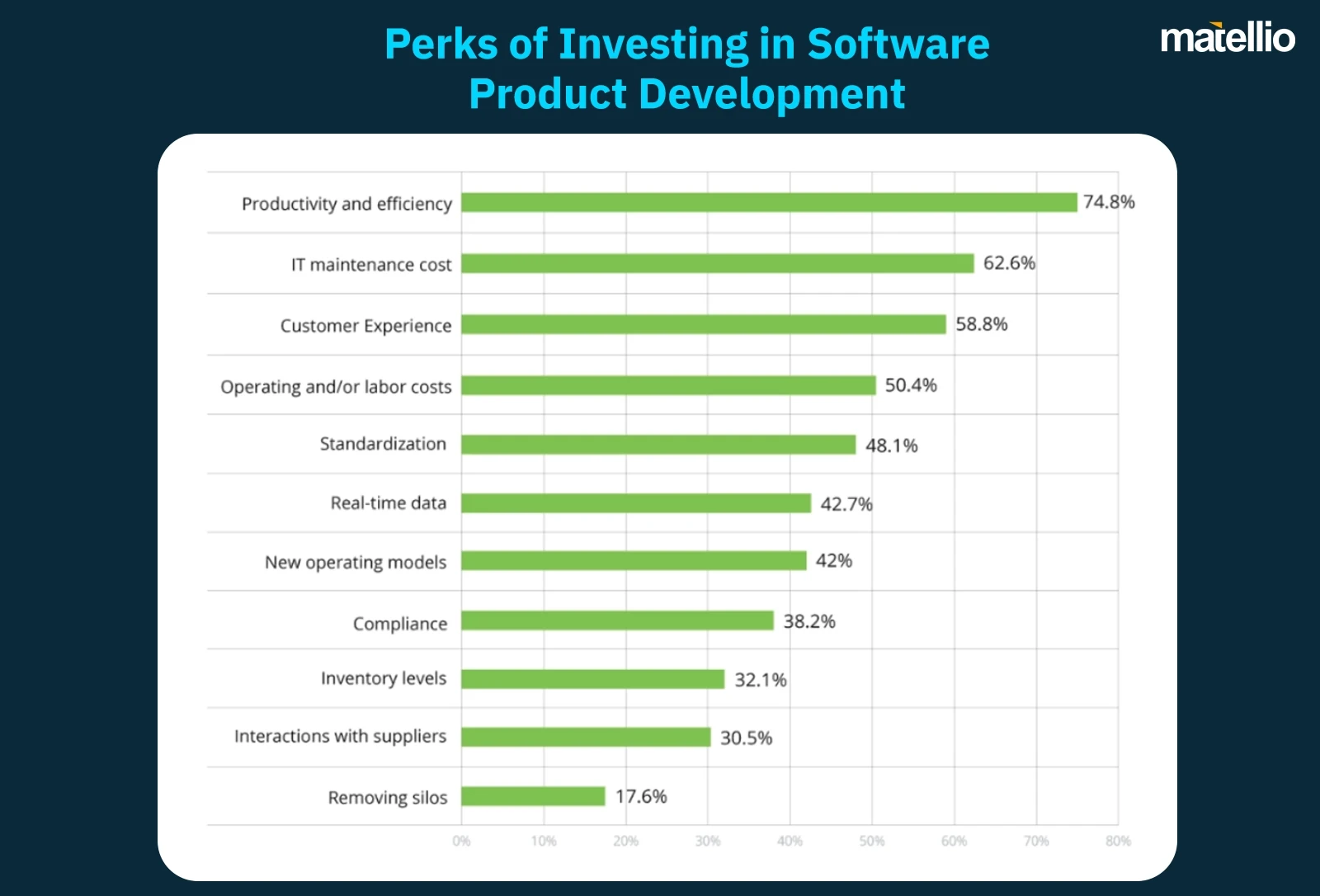
In today’s fast-moving business world, software product development isn’t just optional—it’s essential. Companies that aren’t investing in custom software solutions are falling behind. In fact, 80% of the businesses reported higher revenues after using tailored software solutions.
Enterprise software systems and product development software are what the top players are using to cut costs, streamline operations, and improve customer experiences. With 70% of companies investing in technology for digital transformation to enhance customer satisfaction source, it’s clear: product software development isn’t just about building tools, it’s about driving growth and staying competitive.
What’s your plan to stay ahead? Product development services are the key to creating flexible, scalable solutions that fuel long-term success.
What is Software Product Development?
So, you’re probably wondering, “What exactly is software product development?” Well, think of it like this: it’s the process of building custom software that helps your business solve specific problems. Whether it’s speeding up your operations or giving your customers a better experience, it’s all about creating a solution that actually works for you.

(Source: HubSpot)
Enterprise software development services are not just about writing lines of code. It’s about understanding what your business needs, figuring out how to build the right tools for it, and then actually creating something that solves real problems. Whether you need a custom software product or an enterprise software system, it’s all about designing something that fits your business perfectly.
Now, here’s the kicker: when you build the right software, you don’t just make things easier for your team—you also set yourself up to outperform your competitors. When you partner with the right software product development company, you get more than just a product; you get a strategic solution that’s built to help your business grow. You’re not just keeping up; you’re getting ahead.
What Types of Enterprise Systems Can You Develop with Software Product Development Services?
When you think of enterprise software systems, you might imagine complex, expensive solutions only for large companies. But in reality, any business—regardless of its size or industry—can benefit from custom-developed systems that streamline processes, improve efficiency, and give them a competitive edge. Here’s a list of enterprise systems that you can develop with the right software product development services.
Customer Relationship Management (CRM) Systems
A CRM system is designed to help you manage your interactions with current and potential customers. With CRM consulting services, you can track leads, sales, customer service inquiries, and even build detailed customer profiles. This system can be a game-changer in improving customer satisfaction and driving sales growth.
Features of a CRM System:
- Centralized customer data for easy access and analysis
- Automated tracking of sales, leads, and interactions
- Customizable workflows and reporting tools
- Integration with email, social media, and other communication tools
- Data-driven insights for targeted marketing campaigns
- Mobile-friendly for on-the-go customer management
Enterprise Resource Planning (ERP) Systems
ERP systems integrate all core business processes, including inventory management, accounting, HR, and more, into one unified system. It’s the backbone of most modern enterprises, allowing companies to streamline operations, reduce redundancy, and enhance decision-making with real-time data.
Features of an ERP System:
- Integrated modules for finance, HR, inventory, and more
- Real-time data updates across all departments
- Advanced reporting and analytics for informed decision-making
- Customizable user roles and access control
- Scalable to grow with your business needs
- Cloud-based deployment for accessibility anywhere
Human Resources Management System (HRMS)
An HRMS system helps businesses automate HR tasks such as recruitment, payroll, performance management, and employee records. With AI-based HRM software development services, you can reduce manual processes, improve employee engagement, and make better workforce decisions.
Features of an HRMS:
- Automated payroll and benefits management
- Recruitment and applicant tracking features
- Performance appraisal and feedback tools
- Employee self-service portal for easy updates and requests
- Compliance management with government regulations
- Real-time reporting for HR insights
Supply Chain Management (SCM) Systems
SCM systems focus on managing the flow of goods and services from suppliers to customers. A custom SCM system helps you monitor inventory levels, track shipments, and optimize supplier relationships. This system ensures that your supply chain is efficient, cost-effective, and adaptable to changing demands.
Features of an SCM System:
- Real-time tracking of inventory, shipments, and orders
- Automated reordering based on inventory levels
- Supplier management and communication tools
- Demand forecasting and analytics
- Customizable alerts for delays or stockouts
- Integration with accounting and invoicing systems
Project Management Systems
A project management system helps your team collaborate, track progress, and manage tasks and deadlines. Whether it’s for internal projects or client-facing work, this system helps keep everything organized and ensures that projects are delivered on time and within budget.
Features of a Project Management System:
- Task assignment and deadline tracking
- Real-time collaboration and document sharing
- Gantt charts and other project visualization tools
- Time tracking and resource management
- Milestone tracking and progress reports
- Integration with other productivity tools like Slack or Microsoft Teams
Business Intelligence (BI) Systems
A BI system helps you gather, analyze, and visualize your business data to make better decisions. By integrating data from different sources (e.g., sales, finance, operations), a BI system gives you insights into your company’s performance, helping you spot trends and optimize strategies.
Features of a BI System:
- Data aggregation from multiple sources for a unified view
- Interactive dashboards and visualizations for quick insights
- Real-time analytics and reporting
- Predictive analytics to spot trends before they happen
- Customizable metrics and KPIs for specific business goals
- Integration with existing CRM, ERP, and other systems
Inventory Management Systems
Custom inventory management software helps businesses track stock levels, manage warehouses, and automate orders. With the right system, you can reduce stockouts, optimize storage, and get a clearer picture of your inventory in real time, no matter the scale of your business.
Features of an Inventory Management System:
- Real-time tracking of stock levels across multiple locations
- Automated restocking and reorder points
- Barcode scanning for quick item tracking
- Integration with suppliers and purchase orders
- Reporting and analytics to track inventory trends
- Multi-currency and multi-location support for global businesses
Accounting and Finance Systems
Accounting systems manage your business’s finances, from invoicing to payroll and expense tracking. A custom-built system ensures that your financial data is accurate, streamlined, and secure, with real-time access to your company’s financial health.
Features of an Accounting System:
- Automated invoicing and payment tracking
- Real-time financial reporting and analytics
- Tax compliance and reporting tools
- Integration with banks and payment gateways
- Expense tracking and budget management
- Multi-currency support for global transactions
Looking for a Trusted Software Development Company? Your Search Ends Here. Contact Us Today!
Key Stages in Software Product Development
Building a successful software product isn’t a one-and-done task—it’s a structured process. It takes time, planning, and the right approach at every stage to create something that solves real problems, drives business success, and gives you a competitive edge. Here’s a breakdown of the key stages in software product development that any business can benefit from, no matter the industry.
Ideation and Market Research
The first step in developing any software product is understanding why it needs to exist. This is the ideation and market research phase, where we dig into user needs, explore market gaps, and figure out how your custom software solution can provide unique value. The goal is to understand the problem your software will solve and identify the features that will set it apart in a crowded market.
We partner with you to validate your idea, using tools like surveys and competitor analysis to make sure the product addresses real user needs. This research also ensures that your product has the potential to succeed in today’s market.
Key Takeaways:
- Define real user pain points
- Analyze gaps in the market and competitor products
- Validate your idea with data and market research
- Identify your product’s unique selling points
- Set the foundation for a custom software product built for your business
Planning and Strategy
Once the idea is validated, the next phase is planning and strategy. This is where we create the blueprint for your software product development. We define the goals, scope, and technical requirements, and set timelines. We’ll also decide whether to start with an MVP (Minimum Viable Product) to test core features with real users before going full scale.
By creating an MVP, we’re able to gather early user feedback and test the product’s viability without committing too many resources upfront. This approach helps refine the product for maximum impact while keeping costs in check.
Key Takeaways:
- Define technical requirements and project scope
- Build an MVP to test essential features
- Gather early user feedback to refine the product
- Set clear product development milestones and timelines
- Focus on scalability and cost-effective solutions
Design and Prototyping
The design and prototyping stage is where your product starts to take shape. This phase is all about user experience (UX)—creating wireframes and interactive prototypes that demonstrate how the product will look and function. We’ll work together to ensure that the product isn’t just visually appealing, but also easy to use.
We make sure that the design aligns with UI/UX best practices to ensure your software product is intuitive and enjoyable to use. By focusing on user-centered design, we’re ensuring that your product will keep customers engaged and satisfied.
Key Takeaways:
- Create wireframes and prototypes to visualize the product
- Focus on user-centered design and usability
- Integrate UI/UX best practices for optimal user experience
- Align design with business goals and user needs
- Iterate on designs based on stakeholder feedback
Development and Testing
Now comes the real work: the development phase. Here, we start bringing your software product to life by coding the solution. We choose the right technology stack for your product’s goals and ensure that the product is scalable, secure, and reliable. The development process is done in agile sprints, allowing for flexibility and quick iterations.
Continuous testing (QA) is crucial during this phase. We ensure that every feature works as expected and that any issues are caught early. This step also ensures the product will scale as your business grows.
Key Takeaways:
- Develop using the best technology stack for scalability
- Integrate continuous QA testing for quality assurance
- Use agile methodology for quick iterations and improvements
- Ensure your product is secure and reliable
- Focus on scalability and performance optimization
Launch and Deployment
The launch is the big moment when your software product is ready to meet the world. During the launch and deployment phase, we finalize the product, package it, and prepare it for the market. We’ll also optimize the software for performance and ensure it’s ready for smooth deployment.
This phase may involve rolling out the product in stages to gather early user feedback and refine features. A successful launch isn’t just about getting the product into users’ hands—it’s about setting it up for long-term success with positive reception and adoption.
Key Takeaways:
- Finalize the product and prepare for launch
- Ensure smooth deployment with proper planning
- Gather early user feedback and make quick adjustments
- Use a phased release strategy to control rollout
- Optimize for performance and user experience
Post-Launch Support and Maintenance
The post-launch support and maintenance phase is just as important as the launch itself. After the product goes live, we ensure it stays functional and relevant. This includes regular updates, fixing bugs, and responding to user feedback with new features.
We use product development management software to track issues, monitor usage, and plan updates that keep your product aligned with user needs and market trends. Continuous support helps ensure that your software product remains competitive and delivers ongoing value.
Key Takeaways:
- Provide ongoing maintenance and bug fixes
- Roll out new features based on user feedback
- Ensure software security and scalability over time
- Keep the product aligned with market trends
- Use product development management software for tracking and updates
Common Challenges and How to Overcome Them
Creating a successful software product is no walk in the park. From tight budgets to technical hurdles, every project faces its challenges. But with the right strategies, you can turn these roadblocks into steppingstones. Here’s how to tackle the most common issues in software product development:
| Challenge | Solution |
| Resource Allocation and Budget Constraints | Focus on an MVP with core features to test viability and save costs. |
| Scalability Issues | Use cloud integration services to design a scalable, flexible system. |
| Changing Requirements | Use agile development for flexibility and iterative improvements. |
| Technical Debt and Code Quality | Maintain high coding standards and use product development management software for quality checks. |
| Integration with Legacy Systems | Build flexible APIs for seamless integration with legacy systems. |
| Data Privacy and Security | Prioritize security with encryption, audits, and compliance measures. |
| User Adoption and Training | Provide clear onboarding and intuitive design to boost user adoption. |
Resource Allocation and Budget Constraints
Challenge: Limited budget and resources make it tough to deliver everything you want, often leading to scope creep and delays.
Solution: Focus on an MVP—only the core features. This keeps costs low, gets user feedback early, and helps prioritize what really matters.
Scalability Issues
Challenge: Products not built with scalability in mind can struggle with growing users or new features, causing performance problems.
Solution: Plan for growth by using cloud integration services to ensure your product can scale easily without a complete overhaul.
Changing Requirements
Challenge: Market shifts or new customer demands can throw off timelines and inflate costs if not managed properly.
Solution: Use agile development to stay flexible and iterate quickly, adjusting to changing needs without losing momentum.
Technical Debt and Code Quality
Challenge: Rushing development can lead to technical debt, causing long-term maintenance headaches.
Solution: Stick to high coding standards and regular code reviews. Use product development management software to keep everything in check.
Integration with Legacy Systems
Challenge: New software doesn’t always play well with old systems, leading to compatibility issues and extra work.
Solution: Build flexible APIs from the start to ensure seamless integration with existing systems, saving time and hassle later on.
Data Privacy and Security
Challenge: Growing privacy regulations and security concerns can leave your product vulnerable if not properly addressed.
Solution: Implement top-tier security practices—encryption, access control, and regular audits—to keep user data safe and compliant with regulations.
User Adoption and Training
Challenge: Even the best product can flop if users don’t know how to use it or see its value.
Solution: Offer clear training, easy onboarding, and intuitive design. With custom software development, you can tailor the experience to make adoption smoother.
Ready to Build Secure, Scalable Software for Your Business? We Can Help! Schedule a Free 30-min Consultation Today.
Why Choose Matellio?
When it comes to choosing the right software product development partner, you need someone who truly understands your business and can turn your ideas into reality. That’s where we come in. At Matellio, we don’t just build software—we build solutions that help your business thrive, no matter the industry or challenge. Here’s why partnering with us is a no-brainer:
We Build Software That Fits Your Business, Not the Other Way Around
Let’s face it—every business is different. That’s why a one-size-fits-all approach doesn’t work. At Matellio, we take the time to understand your unique needs and design a custom software solution that works for you. From enterprise systems to mobile apps, we tailor every aspect of the project to help you reach your goals.
We Keep It Simple and Transparent—No Surprises
We know how frustrating it can be to feel out of the loop or deal with constant delays. That’s why we keep things simple, clear, and transparent from start to finish. With our agile development process, you’ll see progress in real-time and be able to provide feedback at every step. We’re all about making sure you’re involved and in control—no surprises, just results.
We’ve Got the Experience You Can Trust
With 15+ years in the business, we’ve worked with companies of all sizes—delivering scalable, secure, and robust solutions. Whether you’re in healthcare, finance, retail, or another industry, we’ve got the expertise to build software that’s not only functional but makes your business run better. You’ll feel confident knowing you’re working with a team that truly gets what you do.
We Bring the Latest Tech to the Table
We’re always ahead of the curve. From AI integration services to cloud solutions and IoT, we make sure your product is built with the latest technologies so it’s future-ready. With Matellio, you’re not just keeping up with the competition—you’re setting the pace.
Quality & Security Are Always a Priority
We’re serious about quality and security. Our team follows best practices to ensure your product is bug-free, secure, and built to last. We run rigorous testing to make sure everything works seamlessly, and we prioritize data protection to keep your users safe. You can trust us to deliver software that’s reliable and secure, every time.
We’re with You for the Long Run
Your success doesn’t end at launch—and neither does our support. With post-launch maintenance and ongoing updates, we’re here to help your product evolve as your business grows. Whether it’s scaling up, adding features, or fixing bugs, we’ve got your back for the long haul.
We Deliver on Time and on Budget
We know how crucial timelines and budgets are. When you partner with us, you can expect timely delivery without breaking the bank. From the moment we start, we’ll work closely with you to set realistic goals and deadlines—and we’ll hit them, guaranteed. We’re all about delivering value, without stress.
With Matellio, you’re not just getting a software product development partner—you’re getting a team that’s dedicated to your business’s success. Let’s work together to create a solution that doesn’t just meet your needs but exceeds them. Schedule a FREE 30-min consultation today!
FAQs
Q1. How do you approach software product development?
Our process begins with in-depth market research, followed by defining the scope, creating a strategic roadmap, and then moving through design, development, and testing. Each phase is meticulously managed to deliver a high-quality product that meets your specifications.
Q2. Can you integrate custom software with our existing systems?
Absolutely. We ensure seamless integration with your existing IT infrastructure, whether it's a CRM, ERP, or other business tools, ensuring smooth data flow and enhanced operational efficiency.
Q3. What security practices are in place for software product development?
We prioritize security by implementing measures like encryption, multi-factor authentication, and regular security audits. Our products comply with global standards such as GDPR and HIPAA to keep your data safe.
Q4. How long does it take to develop a software product?
The development timeline depends on factors like the project's complexity, desired features, and integration requirements. After understanding your requirements, we provide detailed roadmap to ensure timely delivery.
Q5. What is the cost of developing a software product?
The cost varies based on the product's complexity, features, and compliance needs. We offer flexible pricing models to accommodate different budgets while ensuring a high return on investment.



